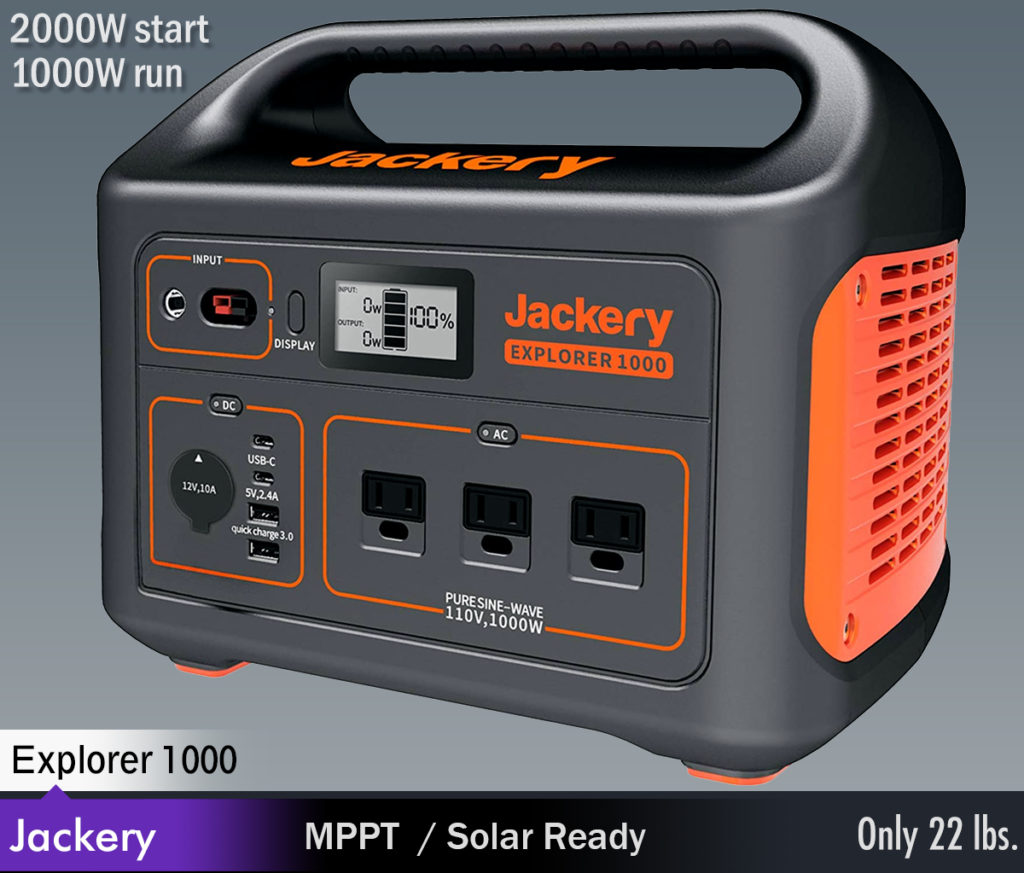
What’s an indoor generator? Well, it’s essentially a battery generator — completely silent and safe to use indoors, which makes them a must have for the inevitable power outages. They’re also referred to as “portable power stations.’ They’re my favorite type of generator because they produce clean energy, they’re silent, are easy to use and, super portable, are ideal to power all of your gadgets, and some are powerful enough to keep your fridge running during a power outage, like the Goal Zero X Series.
I think you’ll be impressed with some of the indoor generators we review. The technology for these products have been increasing at a rapid rate over the past couple years.
I’ve been living in an apartment for about 4 years now, and rely on my computer for all the work that I do. This is a nice place, with everything that I could possibly need. Reliable high speed internet, friendly neighbors, and plenty of shops/ restaurants within a couple hundred meters. Even the weather is pretty nice in this part of the country.
We’re going to review a range of indoor battery generators to match whatever your needs might be. Everyone has a different budget and the amount of power you need will depend on a range of factors — BUT, we all have refrigerators and if you can afford it, get an indoor generator which can keep your fridge running. A fridge requires a generator with starting wattage between 1200W to 1500W. We’ll discuss this in detail later in the article.
► Consider This : Charges to 80% in 1 Hr. : EF ECOFLOW PRO
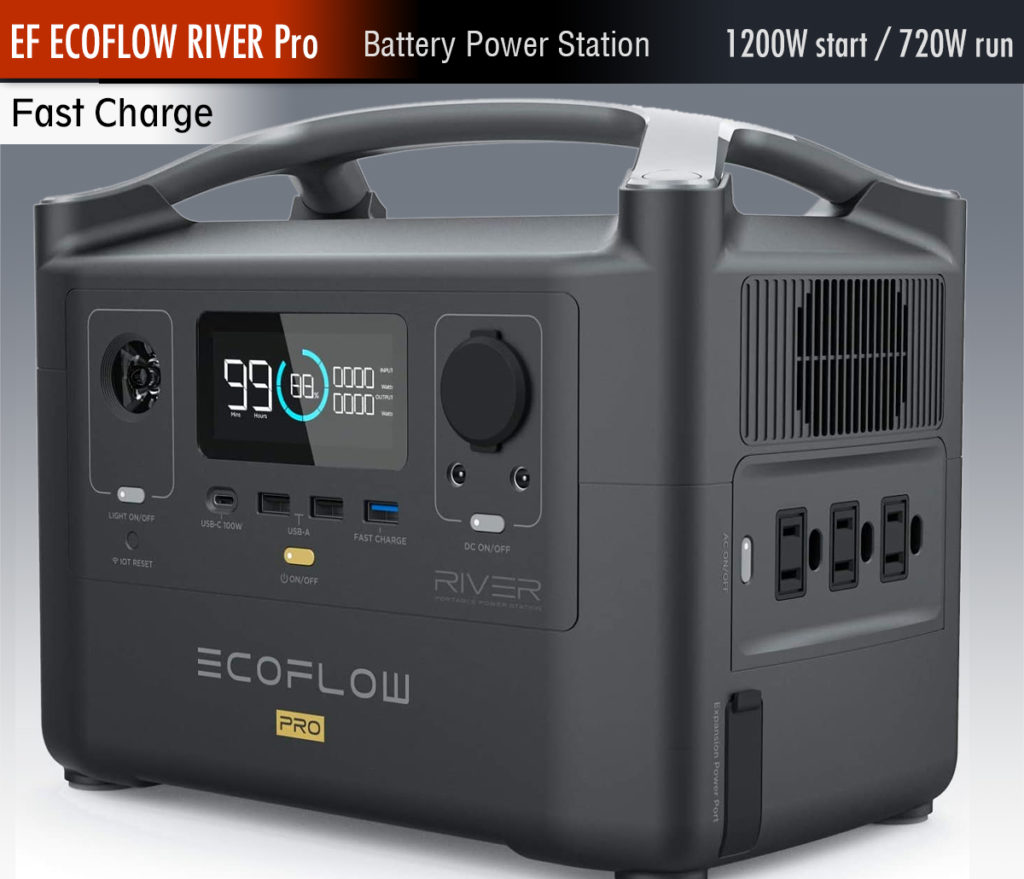
Sizing Up Your Apartment Generator Needs
So what is the only issue for a guy like me who spends pretty much half the day on his computer? Power. Without electricity I can’t work from home, play, watch movies, or communicate with my friends and family. Plus, the fridge and washing machine are going to stop working. Now, we do have a large industrial grade backup generator installed in our apartment. However, it won’t run the fridge/ air conditioning/ bathroom water heater/ washing machine. Generator power is limited to a maximum of 5 amps at 220 volts, so exactly 1100 watts.
That’s enough to run the lights, fans, TV, Wi-Fi router, computer, etc. But not the 2100W Philips induction cooktop I recently purchased to be more self-sufficient during this pandemic. I do a lot more cooking these days, and need the fridge to store all my groceries. You never know when there might be another lock-down. Maybe you won’t have access to food, depending on the nature of the emergency. In truth, the battery generators we cover in this article will only be adequate to get you through several days if the goal is to keep your basic electrical devices charged, and at most, one day if you want your fridge running. That’s enough for most people and will give you much peace at night knowing you can weather a storm.
►Versatile Indoor Power : EGO Power+ : 3000W start / 2000W run
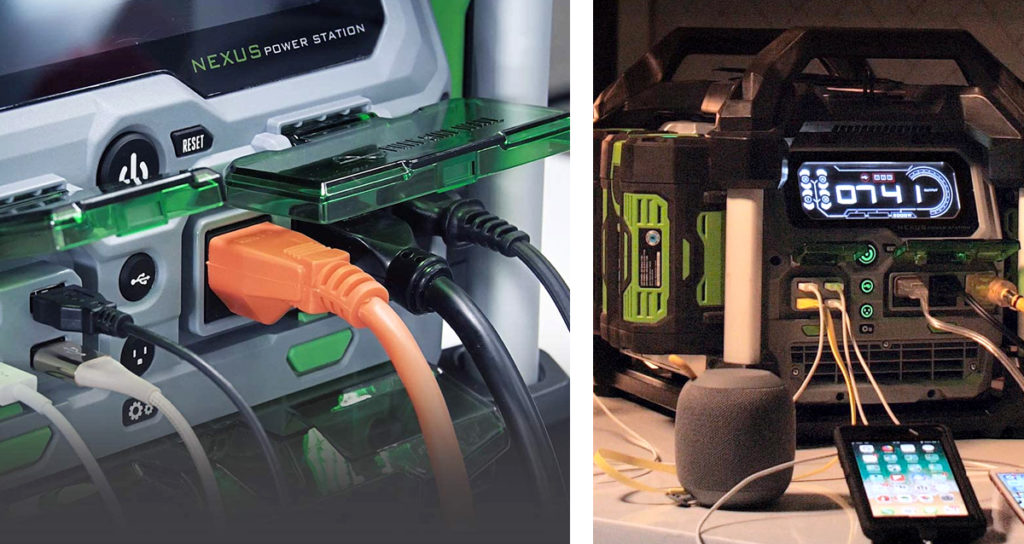
The backup generator in my area is guaranteed to work 90 percent of the time, but sometimes it’ll be down for maintenance or something like that, and that’s when I am left without power for up to 4 or 5 hours at a time. For a guy like me, that’s an eternity. So I’ve been thinking about purchasing a generator to power essential devices such as the refrigerator, computer, cooktop, router, etc. This will come in handy during storm season, or if our apartment generator is down for maintenance.
I do have a balcony, so there’s a slim possibility that I could run a portable inverter generator from there. However, I am not a fan of that idea and will tell you why. Gas-powered generators are noisy, so the people in neighboring flats probably won’t be a huge fan of it. You might think small 800 or 1000 watt inverter generators aren’t THAT loud, but try running a food processor with them. They stay around 50 decibels at half load or less. But once you crank up the load, they will get pretty loud.
And that’s not the worst part either, my bed is at the edge of the room – next to the balcony. There is a door and a sliding window separating me from the exhaust fumes of a running generator. If you do your research on running a portable generator indoors, you’ll find that putting your generator within 5 to 7 feet of any doors or windows is a terrible idea. I don’t want to get poisoned by carbon monoxide in my sleep. A CO detector/ alarm unit will probably help, but I’m not taking that chance.
So, inverter generators are out of the equation for me. And probably for a lot of you reading this article as well. What you need is a portable power station, often referred to as an “indoor generator”. These are essentially giant battery packs connected to an inverter. The inverter takes power from the lithium ion battery pack, steps up the voltage and converts it to alternating current. Then this power is routed to the outlet panel of the generator. They are 100% silent, except for the cooling fans. And there are zero exhaust fumes. These two attributes make them perfect for apartment dwellers.
How Do You Decide Which Apartment Indoor Generator is Right for You?
This one comes down to the kind of equipment you plan to run, how long you plan to run it, and how much space you have. Oh, and don’t forget the budget. Some of us can’t afford to spend several thousand dollars on a backup generator, especially if the power doesn’t go out that often. Most indoor generators are in the 500W to 1000W range. You definitely can run a TV or internet router with one of these. You can also use them to charge your phone or laptop multiple times. However, if you want to run more power hungry stuff or keep the refrigerator on for several hours a 500W indoor generator won’t be enough.
I have reviewed some larger models in this article, one of them is the EGO Power+ NEXUS portable power station. This behemoth weighs over 36lbs with one 7.5Ah battery installed (you can install up to 4 7.5Ah batteries which brings the total weight up to 54lbs). And it can deliver 2000 watts of continuous power with 3000 watts of surge power. This is the kind of indoor generator you purchase when money is not a concern, and you have ample space in your apartment. For me, it’s not going to fit in the room because my living space is already pretty cramped as is. I barely have enough floor space in my room with a bed, chair, cabinet, and computer desk taking up most of the area.
So yeah, floor space is another thing to consider when you purchase an indoor generator. If you have a balcony though, it’s not going to be an issue. Since you can just put the generator outside and hook up an extension cord to power your equipment inside the house. You also have to purchase the proper extension cord rated to handle the amount of power your appliances will draw. Ideally, you would have the generator inside the room and directly plug your appliances into the outlet panel. If you’re placing it outdoors, it also has to be rated for water and dust resistance. Some portable power stations aren’t designed for outdoor usage, especially the really cheap ones that are just meant to charge your phone or camera. So you have to be extra thorough with your research before purchasing one.
If you want to run a fridge with your indoor generator, understand that food will start to spoil after 4 hours of no power. Therefore, let’s say you typically get outages of around 7 to 8 hours. You need a generator that can run the fridge for at least 4 hours. If it’s a freezer, it can keep temperatures under 0°C for a lot longer, typically 24 hours for a half-full unit and 48 hours for a filled up freezer. The more stuff you have in your freezer, the more negative heat energy it has packed up inside (so it stays cool for longer without power).
So for most folks, you won’t require an indoor generator to power your freezer since the utility company will probably have fixed the issue long before 24 to 48 hours (unless a storm has done severe damage to the grid). For those of you who own a refrigerator though, an indoor generator is essential to prevent your food from spoiling.
How much power do I need to run my fridge?
The best way for you to know this is to look at the plate or sticker behind or fridge that has all the voltage and current specifications on it. Multiply volts with amps to get watts consumed. Every make and model is different, and it’s hard to predict the power consumption of your fridge without knowing its volume or usage. A typical domestic household fridge uses 100 to 250 watts of power. Or between 1 to 2 kilowatt-hours of energy per day.
However, a fridge doesn’t consume the same amount of power throughout the entire duration it’s running. A thermostat within the fridge detects when temperatures are below 4°C and turns off the compressor motor. Then, the only thing that needs to be powered is the light when you open the fridge. The compressor cycles for around 8 to 12 hours per day on most fridges. When the compressor is off, power consumption drops drastically. When it kicks back on or defrosting cycles take place, power consumption maxes out. All this is also affected by how much food you have in the fridge and the ambient temperature (it will cycle on more often in summer).
Note: To be on the safe side, you need an indoor generator in the 1200 to 1500W range to power your fridge for the whole day. This is just my estimate, and you might have a large 500L side by side refrigerator running in the summer. In that case, you’ll be better off getting a 2000W portable power station/ indoor generator.
► Refer to the Honda Generator Wattage Guide for more accurate numbers on how much power devices require to operate.
Reviews / Indoor Generators For Apartments
Review | Westinghouse iGen160s : Power Station
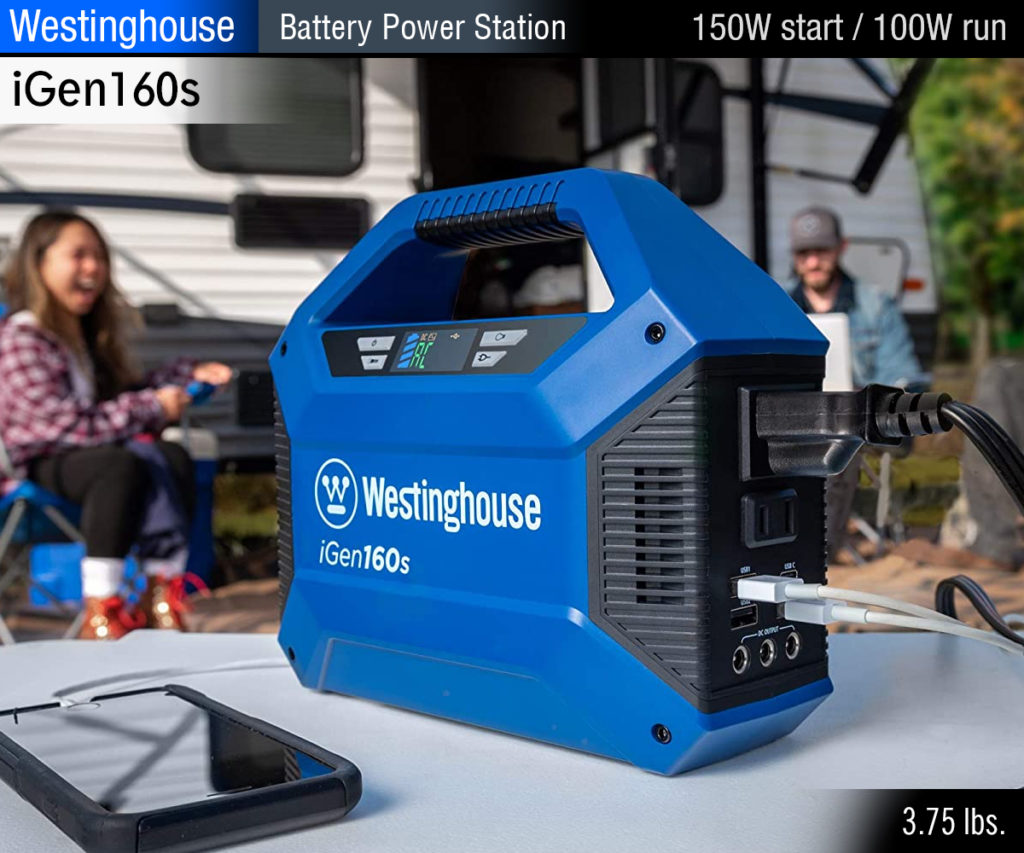
Features :
- Charge up to 9 devices at the same time: pushing 100 rated watts and 150 peak watts through (2) 120v household outlets, (2) usb ports, (1) quick charge usb port, (1) usb-c port, (3) 6mm 9-12v dc outlets – strong enough to easily power a 36″ led tv, box fans, or heated blankets
- 155 watt-hours of lithium-ion battery capacity – provides long-lasting power that charges smartphones up to 17 times, tablets up to 9 times, DSLR cameras up to 16 times, drones up to 23 times – delivers hours of power for a Nintendo switch, Bluetooth speakers, and GPS systems
- Ultra Lightweight at 3.75 lbs. The igen160s is lighter than a full 36 oz. Yeti rambler and smaller than a lunchbox – backpack ready mini generator with a convenient carrying handle and built-in flashlight and reading lights – perfect compact charging station for camping and other outdoor activities
- Charges at home, on the go, or in the field: charges to 80% in less than 6 hours using a household outlet or in less than 7 hours in the car or with a solar panel (panel not included)
- CLEAN power apartment or home generator: reduce your carbon footprint for more sustainable lifestyle – no obnoxious fumes, no messy maintenance, no noise pollution – whisper quiet indoor and outdoor generator
- Safe for sensitive electronics with built-in device & battery guard – short circuit, overload, and temperature protections prolongs battery lifespan & safeguards against damage
- Includes : ac adapter, dc adapter, cigarette lighter plug, manual – backed by 2-year coverage with limited service, labor, and parts coverage with nationwide customer service network
“The iGen160s is an excellent solution for apartment dwellers and travelers who need a tiny power station to charge their phones, cameras, laptop, etc. It even has a built-in flashlight so you can navigate your way around the house at night in complete darkness when the power goes out. This 155W power station is small enough to be placed on the nightstand, next to your phone or lamp.”
Overview:
I really like this little Westinghouse generator because it is so incredibly tiny. And I mean TINY, at just over 8” in length and 7” in height. It isn’t very wide either, at just 3.77”. And the whole thing weighs just 3.75lbs, so you can easily toss one into your travel backpack along with a solar panel. This combined with a 60W solar panel gives you a sustainable long term solution for charging small devices like phones and cameras when you’re on the go.
Or if you live in an apartment, this makes sure that you’re never at danger of being isolated from the rest of the world if there’s a storm that takes out the grid. The iGen160s is very helpful for people working from home on laptops because it can run an Ultrabook with something like an Intel 10th generation i3/i5 for up to 5 or 6 hours. Provided you turn down the display brightness, and aren’t doing any CPU intensive tasks. If you’re just watching videos, browsing the web, or using MS Word this Westinghouse indoor generator will run your 14 or 15” laptop for 5 to 6 hours (plus whatever charge your laptop battery already had before the power outage).
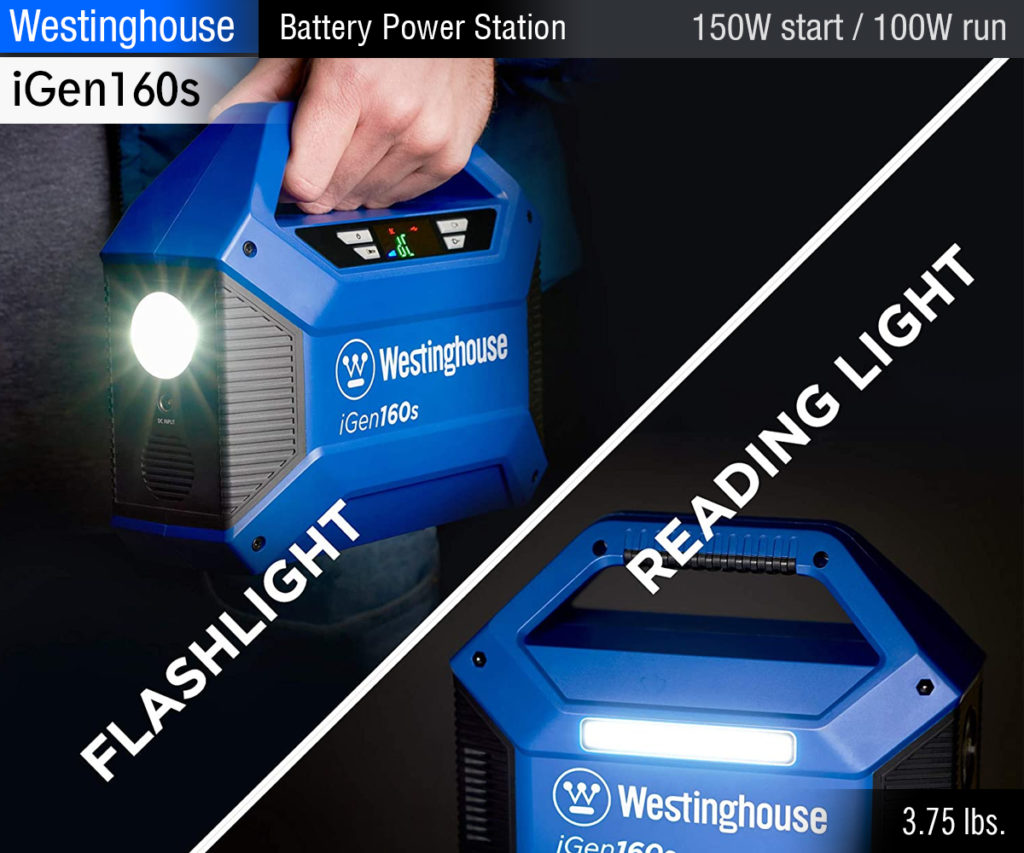
Note : The iGen160s WILL NOT RUN :
It can also act as a flashlight, since there is a LED light built into the front end. This can be toggled on and off very easily with your thumb while holding the carry handle. In fact, all the controls are accessible with your thumb when you’re holding the carry handle. You can also charge AC and DC devices simultaneously. For instance, you could have your phone and a Bluetooth speaker plugged into the USB ports for charging. But your camera battery is running low and you can’t power it from the wall because there’s an outage. Not a problem, just plug the charger into one of the two 120V AC outlets on the iGen160s. You can charge your phone, speaker, and camera battery – all at the same time.
The iGen160s is not meant to be a replacement for an actual generator. In fact, it can’t power most standard home appliances like toasters, microwave ovens, hair dryers, electric/ induction cooktops, etc. But you could probably run a laptop or tv (not at the same time). The maximum output is 155 watts, but that’s only for a short burst. The rated continuous output is 100 watts.
You can charge the iGen160s from any solar panel that has a DC13V-25V/2A Max port. It takes about 6hrs under ideal conditions (no clouds and direct exposure), or around 7 to 8 hours in not-so-ideal conditions. If you have a balcony in your apartment, charging this generator is super easy through solar power. It can also charge from a 12V car port, so you can drive around while this power station charges. There are 3 5.5mm 12V car ports on the iGen160s, along with a USB Type C port and multiple Type A ports (one of which supports quick charging).
EGO Power+ NEXUS PST3041
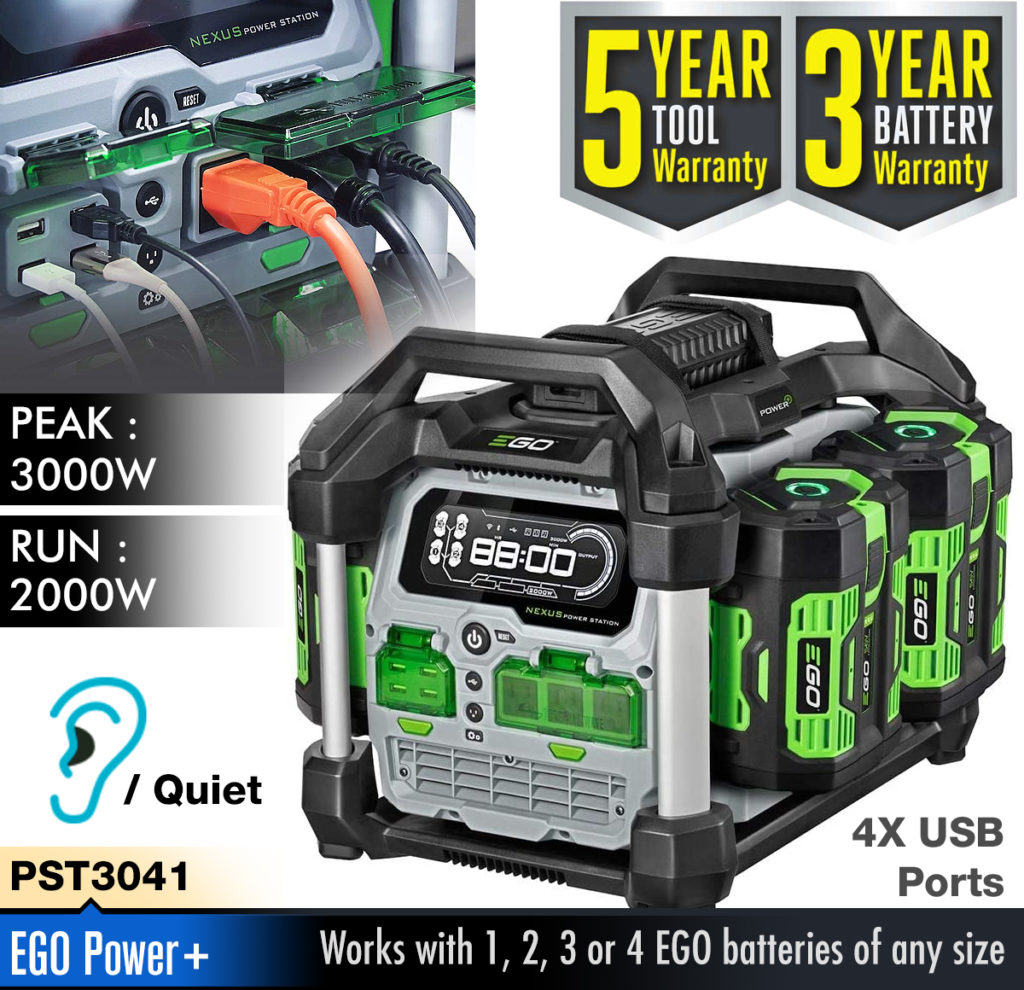
Features :
- 3000W Peak 2000Watt Continuous
- 3x 120V A/C Outlets
- 4x USB Ports
- Bright LED Display Shows Run Time
- Robust Steel Handles
- Battery Powered Alternative to Gas Generators
- Quiet Clean Power for Indoor and Outdoor Use
- 4x Port Battery Charger (when plugged in)
- Weather-Resistant Construction
“An indoor generator with the power to match gas generators, the EGO NEXUS can run nearly every appliance in a typical household. Fridge, TV, electric range, induction cooktop, water heater, desktop PC, air conditioner, etc. It is bulky and expensive, but well worth the price tag if you need a 100% gas and noise free emergency power source. Not only is the EGO NEXUS an excellent emergency generator for high rise apartments, but it’s also a very good camping and jobsite generator.”
Overview:
This is what you want if you’ve got ample floor space in the apartment and don’t mind lifting 50+ lbs. of weight whenever you need to transport the generator into another location. While it’s designed as a gas generator replacement, the EGO NEXUS can’t quite match the performance of a high-end portable gas generator. However, it has two very nice things going for it – zero noise, and zero gas. Since this thing is essentially a giant battery station with an inverter in the middle, there are no moving parts other than the cooling fans. And it does charge via solar power so you can comfortably spend several days or even weeks with the grid down for repairs. And you won’t miss out on any of the comforts of modern life such as TV, internet, refrigeration, air conditioning, etc. (unless you live in Alaska, in which case solar charging isn’t something to be excited about).
There are 4 external mounting points for specially designed 5.0Ah or 7.5Ah battery packs. And you can have anywhere from 1 to 4 batteries installed at any given time. More batteries equals longer backup time, and the ability to run heavy draw equipment such as power tools. If you’ve got a CPAP machine for someone with sleep apnea, this is one of the best indoor generators I can recommend. It is sturdy, weather-resistant, and has ample outlets for powering multiple devices.
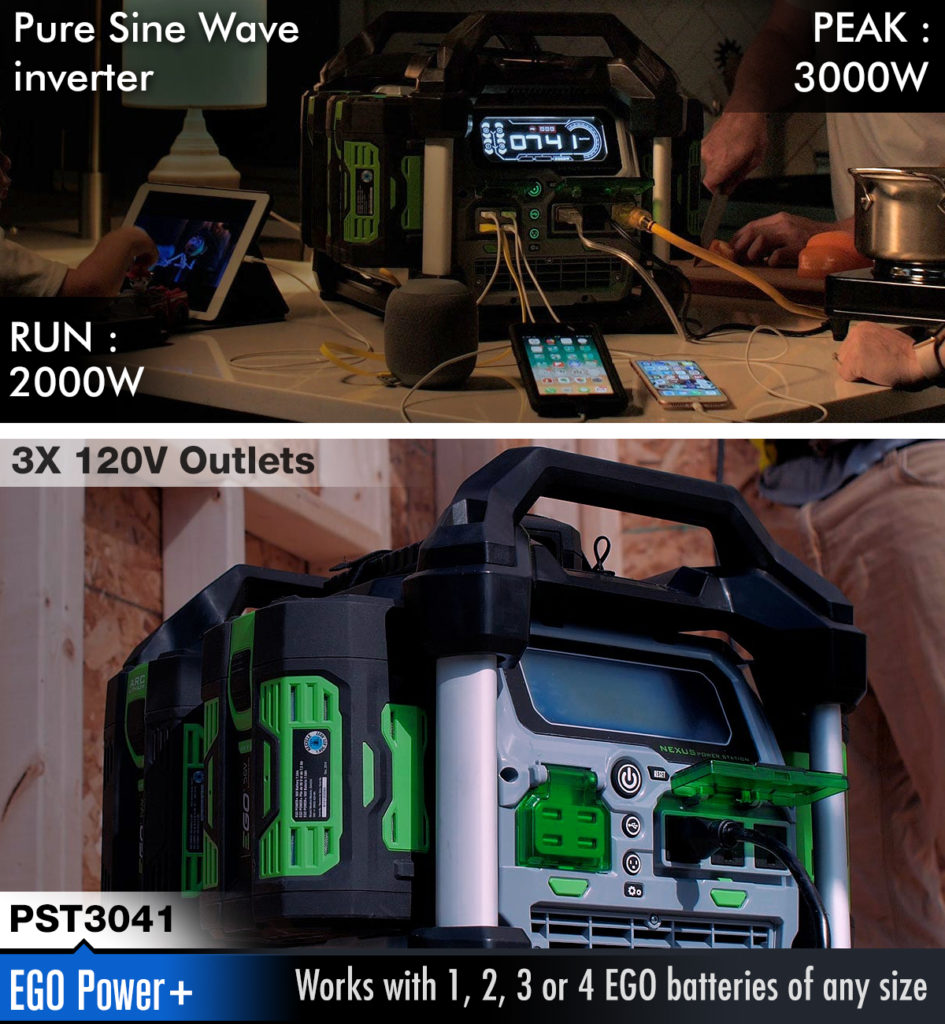
One of the highlights of this indoor generator is its pure sine wave output, unlike many cheaper indoor generators which produce approximated sine wave power. The inverter in the NEXUS is of high quality, delivering power that is steady and clean for any sensitive electronic appliances. Like computers, smart TVs, phones, laptops, cameras, etc. The only real downside to this power station (other than the size) is the fact that it has just 3 AC outlets, despite being capable of supplying 2000 watts of continuous power and 3000W of surge power.
Note: The PST3040 is a tool-only model, meaning you don’t get any batteries. You’ll have to purchase those separately; it accepts EGO ARC lithium-ion batteries of any capacity. For the best performance, you need to get 7.5Ah EGO BA4200T batteries. You can link up the power station with your phone via Bluetooth or Wi-Fi, and turn outlets ON/OFF. You can also see battery charge status, watts per outlet, and other valuable information from a remote location.
Review : Delta 1300 Power Station
Best indoor apartment generator for the money.
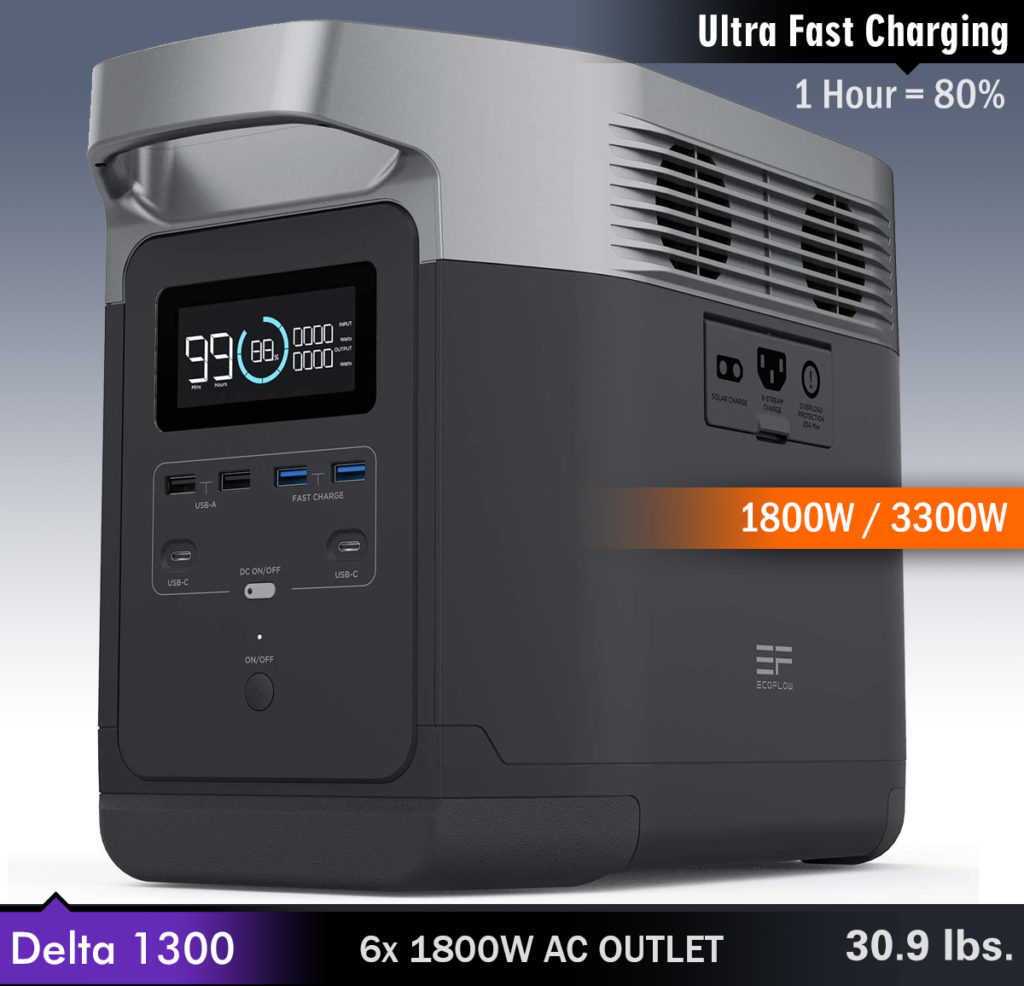
“The Delta 1300 is relatively compact despite having more ports than most large indoor generators like the EGO Power+ NEXUS. It is one of the fastest charging power stations on the market, and can power a wide range of devices from refrigerators to laptops and blenders. The ideal mid-sized indoor generator for anyone living in an apartment who wants clean power.”
Overview:
While it’s not much larger than a standard UPS for a desktop PC, the Delta 1300 packs a ton of juice for running essential appliances during a power outage. This is the one I would most likely purchase as an apartment dweller because of how versatile it is despite being so compact. There are 6 two-prong 120V AC outlets on the back (someone at EGO needs to take notes), each capable of up to 1800 watts of continuous power and 3300 watts of peak power.
And you can power pretty much anything with this indoor generator – your PS4, 50” OLED TV, fridge, food processor, coffee machine, laptop, phone, lights, etc. It can store up to 1260Wh of energy in its Lithium Ion battery, and can actually output at extremely high rates relative to its battery capacity. Each AC port can supply up to 1800 watts of continuous power, which is just 200 less than what the EGO Power+ NEXUS can manage. Except this is less than half the size of the latter.
Runtime is another story though; your Delta 1300 won’t last very long when you draw the maximum 1800 watts of power. The EGO Power+ NEXUS on the other hand can accommodate four 7.5Ah batteries, each with a capacity of 420Wh. So it can run longer. But there isn’t a massive difference in runtime, more like 20 to 30 percent. And the Delta 1300 is a lighter, more easily manageable package. It also charges faster, going from 0 to 80 percent in just one hour (1.6hrs for empty to full). You can connect 4 ECOFLOW 110W solar panels to get it from full to zero in just 8 hours. You could purchase ECOFLOW solar panels, or use whatever existing panels you have since it has universal solar panel inputs.
Jackery Portable Power Stations (240/ 500/ 1000 watts)
Jackery Explorer portable power stations are light, rugged, and designed for everything for indoor usage to camping and hiking. All Explorer series power stations support charging via solar panels, making them an excellent choice for people living off-grid. I am going to review 3 of their most popular models today – the E240, E500, and E1000.
Review : Jackery Explorer 240 —
One of the most popular and great value Indoor Apartment Generators
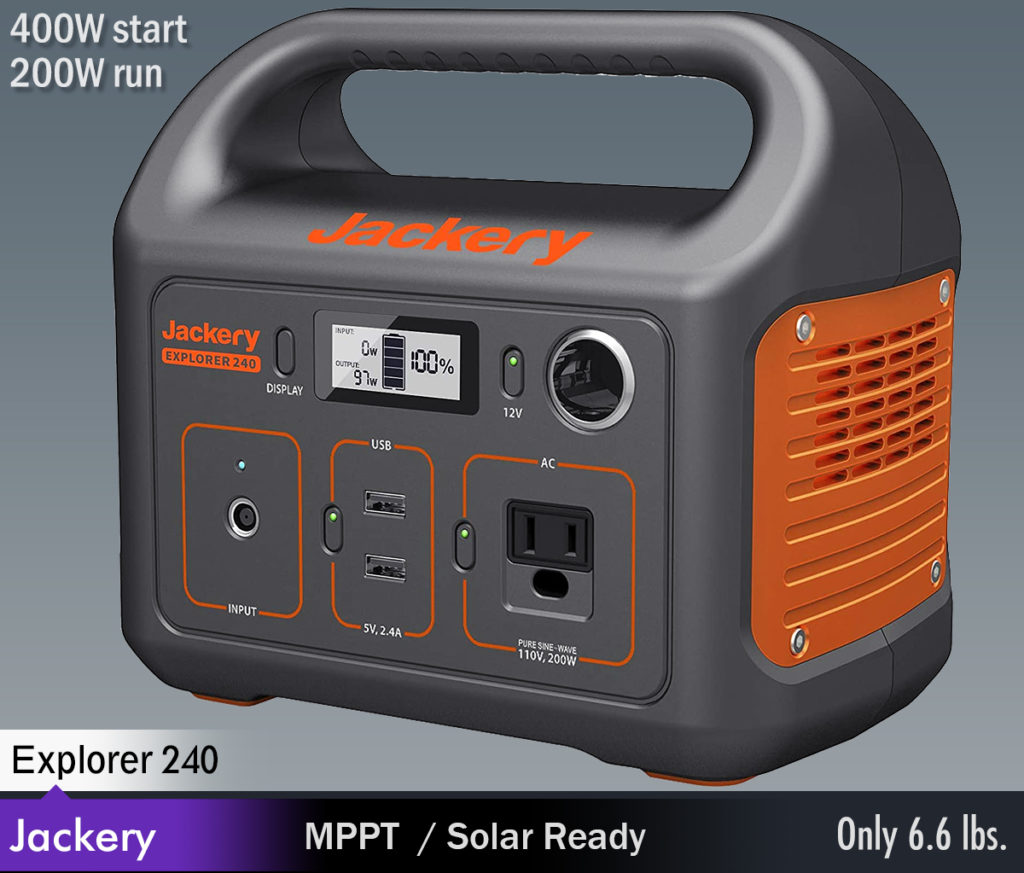
“A handy lunchbox-sized portable 240W power station for apartments and campers. The Jackery Explorer 240 combines portability and ruggedness, weighing just 6.6lbs while being capable of running a mini cooler or laptop for several hours.”
Overview:
All indoor generators are silent, but the E240 is especially quiet. One of the most noticeable differences when you plug a laptop into this and the Westinghouse iGen160s is that the Westinghouse power station will make these weird buzzing and clicking sounds. They are not very loud, but you can hear them if there’s nothing else going around nearby.
For someone like me working alone at home in my room, that is especially noticeable. Not only does the E240 have significantly more capacity than the iGen160s, but it also runs dead silent even when you’re powering your MacBook Pro off of it. The E240 also integrates all 3 charging solutions (solar, 12V car adapter, 120V AC) into one single port for convenience. There are 2 5V USB Type A ports, no Type C ports though. And a single 120v AC port from the inverter. In terms of ports and weight, the iGen160s has the upper hand. But it lacks the ultra-quiet operation and higher capacity of the E240.
Review : Jackery Explorer 500 —
Recommended Indoor Apartment Generator
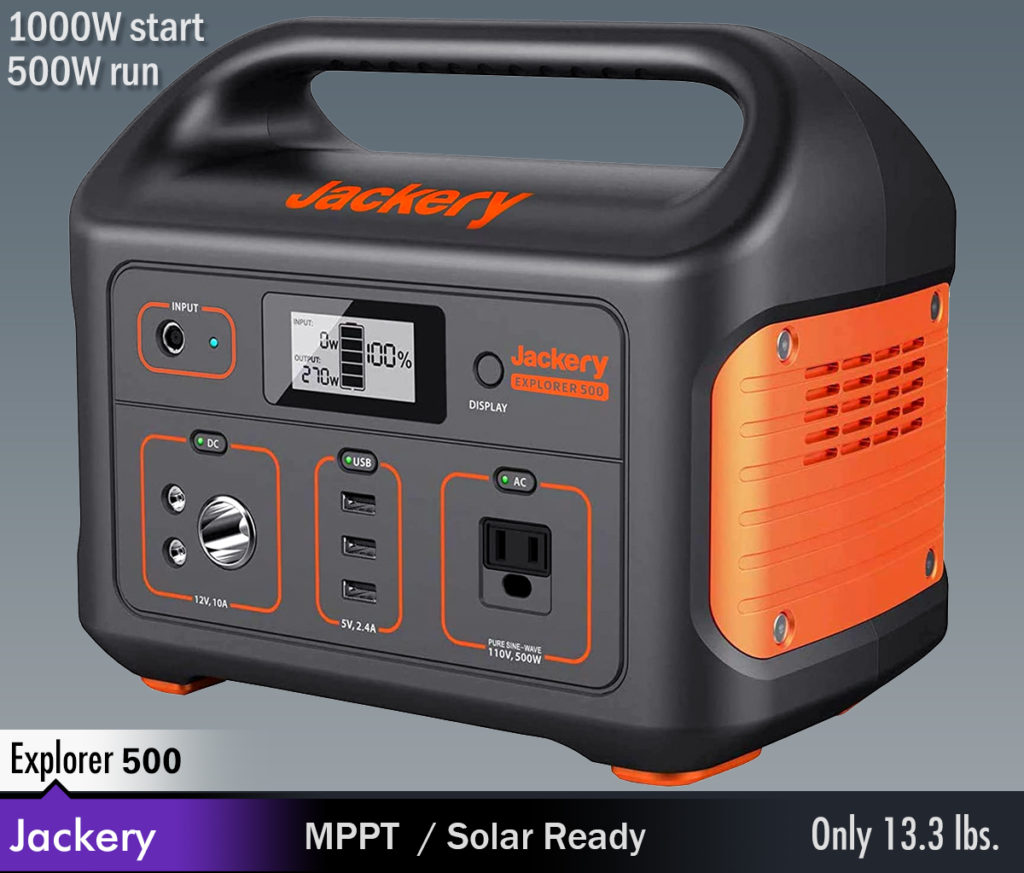
“500 watts is enough to run a compact fridge or a television set for 3 to 4 hours, with enough capacity left over to power some LED lights during an emergency. You get more ports than the Explorer 240 and slightly over twice the capacity. ”
Overview:
While the E240 can run laptops and lights, it isn’t the best choice for when you want to run the TV or game console. The E500 is more suited to running things like your TV, media center, blender, CPAP machine, etc. It has over twice the capacity of the E240 and is about 2 inches bigger in every dimension. Still a very compact package, and weighs just 13.32lbs so you can easily carry it between the car and apartment. The Explorer 500 also supports charging from a solar panel and has a MPPT charge controller for faster charge times from solar power. For some reason it has only one 110V AC outlet (and still no Type C port).
FACT : What is an MPPT charge controller? MPPT stands for : Maximum power point tracking. It’s basically an electronic system that maximizes the amount of power from photovoltaic (PV) modules under all the conditions it operates under. It optimizes power, plain and simple.
The efficiency of the system is optimized when the load characteristic changes to keep the power transfer at highest efficiency. This load characteristic is called the maximum power point (MPP). MPPT is the process of finding this point and keeping the load characteristic there. Electrical circuits can be designed to present arbitrary loads to the photovoltaic cells and then convert the voltage, current, or frequency to suit other devices or systems, and MPPT solves the problem of choosing the best load to be presented to the cells in order to get the most usable power out.
Wikipedia
Review : Jackery Explorer 1000 —
Recommended Indoor Apartment Generator
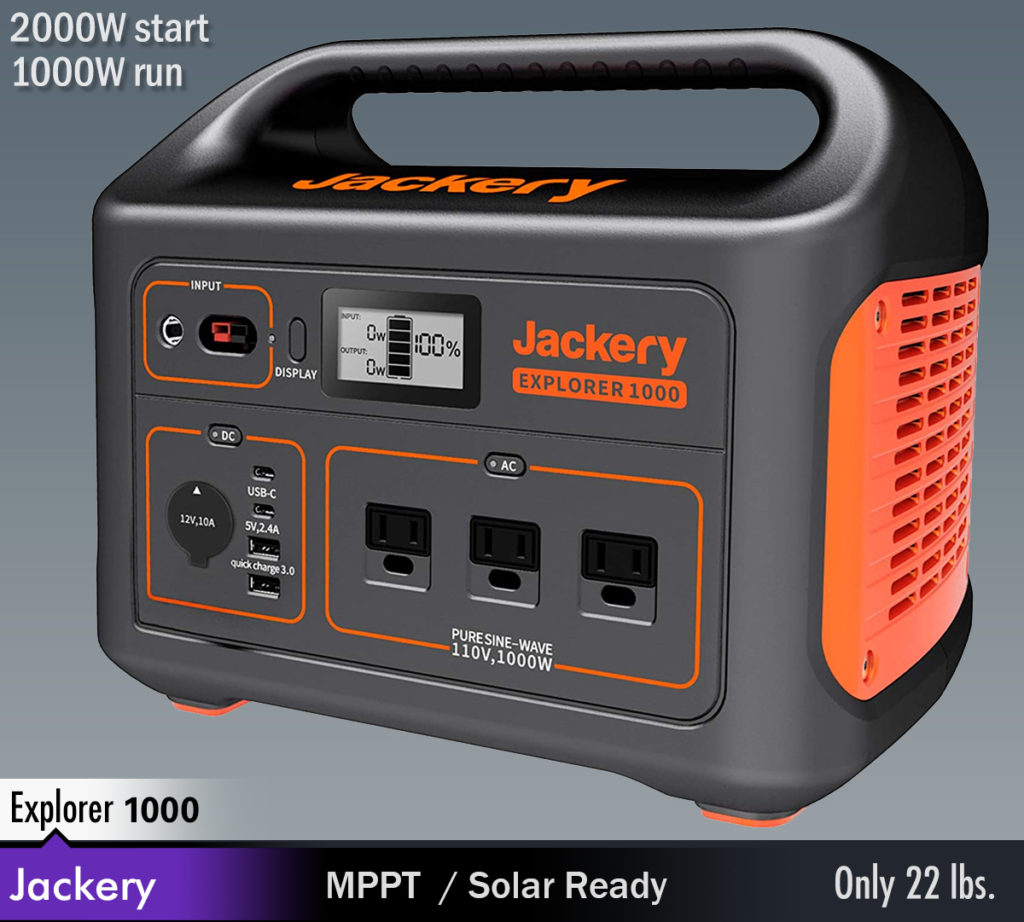
Features :
- Larger Capacity and Higher Wattages: 1002Wh(46.4Ah) lithium battery capacity, 1000W Rated Power and 2000W Surge Power.
- Multiple Output Ports: Two USB-C, two USB, one DC carport & three AC outlets (with the pure-sine wave). Going off-grid and being able to power your cameras, computers, communication devices and also a CPAP and electric grill.
- Green Outdoor Power Solution: Efficient solar charging with MPPT built-in makes it a solar generator for outdoor recreations. Charge the battery to full around 8 hours by connecting two SolarSaga 100W with an adapter cable (package included).
- Portable and Compact: Weighs only 22lbs, it is carry-friendly with an easy-carry handle.
- The LCD screen with charge/discharge data and battery life status.
“With 1000 watts of continuous power output and up to 2000 watts of surge power the EXPLORER 1000 is perfect for running your CPAP machine overnight or keeping the food from spoiling in the refrigerator. It can charge from a solar panel or 12V car adapter if you don’t have access to a wall outlet.”
Overview:
If you want outlets so you can actually run stuff with your indoor generator, get the Explorer 1000. This is the one I recommend over the E500 which barely has any ports. If you want to go compact by sacrificing some ports, get the E240. If you want the ability to power multiple devices simultaneously with longer run-times, get the E1000.
It has 3 110V AC ports, each one can handle up to 1000W continuous and 2000W surge. You can run a blender, electric grill, coffee maker, crock-pot, or CPAP machine with this indoor generator. It can charge a MacBook Pro 13 up to 8 times, so you can get through multiple days of work. And it can power a 5W light for up to 76 hours. Also, this Explorer model has two Type C ports (finally).
Review : Goal Zero Yeti 200X —
Recommended Indoor Apartment Generator
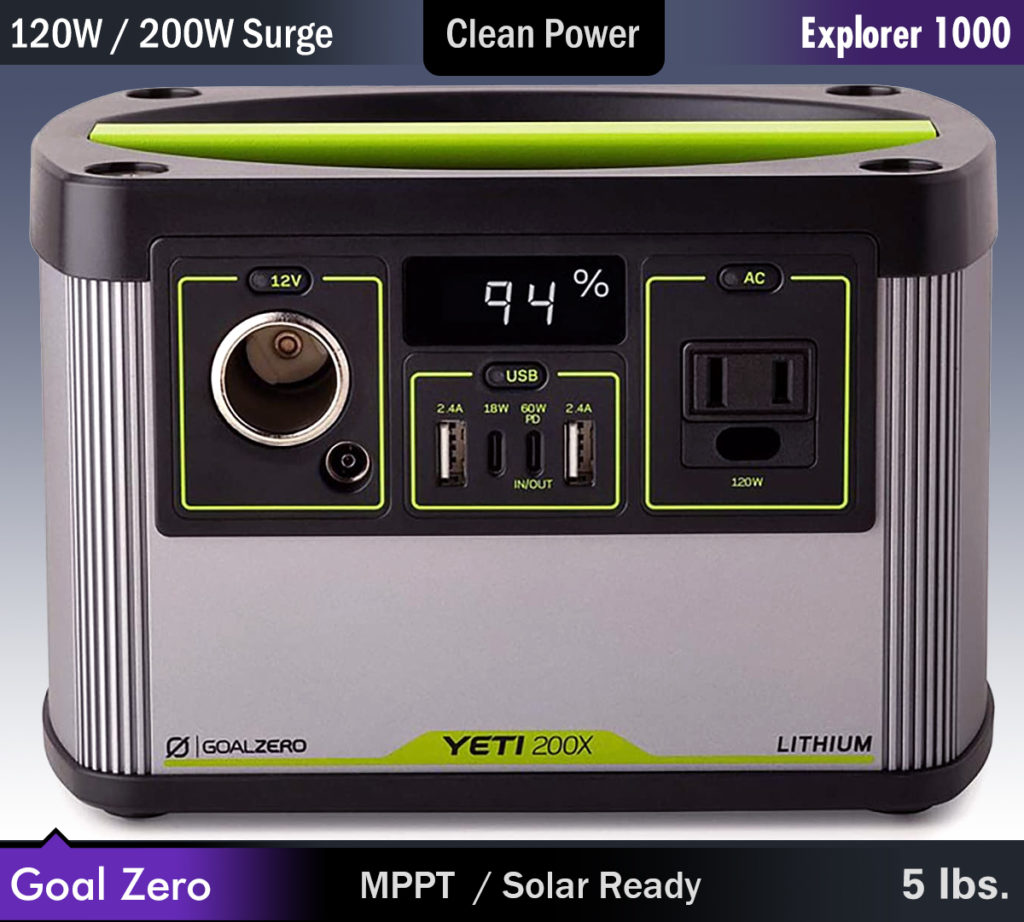
Features :
- Engineered with precision here in the U.S. Every feature has a purpose, designed with a real-life use case in mind. Lightweight, portable power gives you the freedom to travel anywhere.
- Community of over 31,000 people around the world including disaster relief projects. Based along the Wasatch front in Salt Lake City, Utah.
- Professional grade power | Built to last and survive. Field-tested in a wide range of environments, from the Arctic to job sites to the home. Six different output ports let you power a range of devices including lights, phones, laptops, medical devices, cameras, portable fridges, and more.
- OUTLETS : 2x USB-A, 18W USB-C, 60W USB-C PD, 6mm, 12V, 120V AC Inverter. 200 watt hours of lithium power charges your phone 16 times, laptop 4 times, and let’s you run LED lights for up to 42 hours.
- High-speed 60W USB-C Power Delivery port lets you fast charge compatible laptops, smartphones, and tablets. Integrated MPPT charge controller ensures the most efficient solar charge possible. Recharge your Yeti 200X from the sun in as little as 2.5 hours with our 100W solar panels, or recharge from the wall in 4 hours with included 60W power supply.
- Safe and user-friendly : We prioritize product safety, backed up with multiple layers of protections. Over and under voltage protections, temperature protections, battery management system to monitor individual cell and battery pack health. Yeti 200X comes backed with a 2-year warranty. All elements of the product from physical construction to user interface are designed for ease of use.
- panels while away from the grid and keep it topped off from a wall outlet when you’re home.
- FROM THE SUN : Recharge from the sun by connecting a compatible solar panel, either the foldable Nomads or mountable Boulder solar panels. The higher the watts of the panel, the faster the charging times.
- FROM THE WALL : Plug it into the wall. Fully recharges in 4 hours using included 60W power supply, or plug in with the Yeti X 120W Power Supply to halve that charge time.
- FROM THE CAR : Plug into your vehicle’s 12V outlet using the Goal Zero Yeti Lithium 12V Car Charging Cable.
►NOTE: Do not attempt to charge your Yeti Lithium from a 12V source using any other cable. Doing so may cause damage to the unit.
“With a wide selection of ports, tons of charging options including solar, and an extremely compact design the Goal Zero Yeti 200X will fulfill your needs perfectly. That is, if you just want something compact to charge your phone, laptop, and camera. ”
Overview:
The Yeti 200X competes with both the Explorer 240 and iGen160s. It is heavier than the iGen160s, but lighter than the E240. And in terms of ports, it has both beat. The Yeti 200X has a great inverter that delivers 120 watts of continuous power, or 200 watts of surge power from the 187Wh Li-Ion NMC battery pack. You get two Type C ports, one of which is a 60W PD port that can also be used to charge the power station. There is a tiny cooling fan on the back that kicks in when temps get toasty. It’s extremely silent, and the noise is directed away from you.
I really like the fact that the Yeti 200X can charge from solar, via Type C, or from your car with the 12V port. It can output up to 10 amps of power from its 12V car port, and the 6mm 12V port also supplies 10 amps of power for small tools. The Yeti 200X will power your laptop, drone, mobile phone, and run LED lights overnight. Or even a portable fan.
Review : Energizer PPS240W01 —
Recommended Indoor Apartment Generator
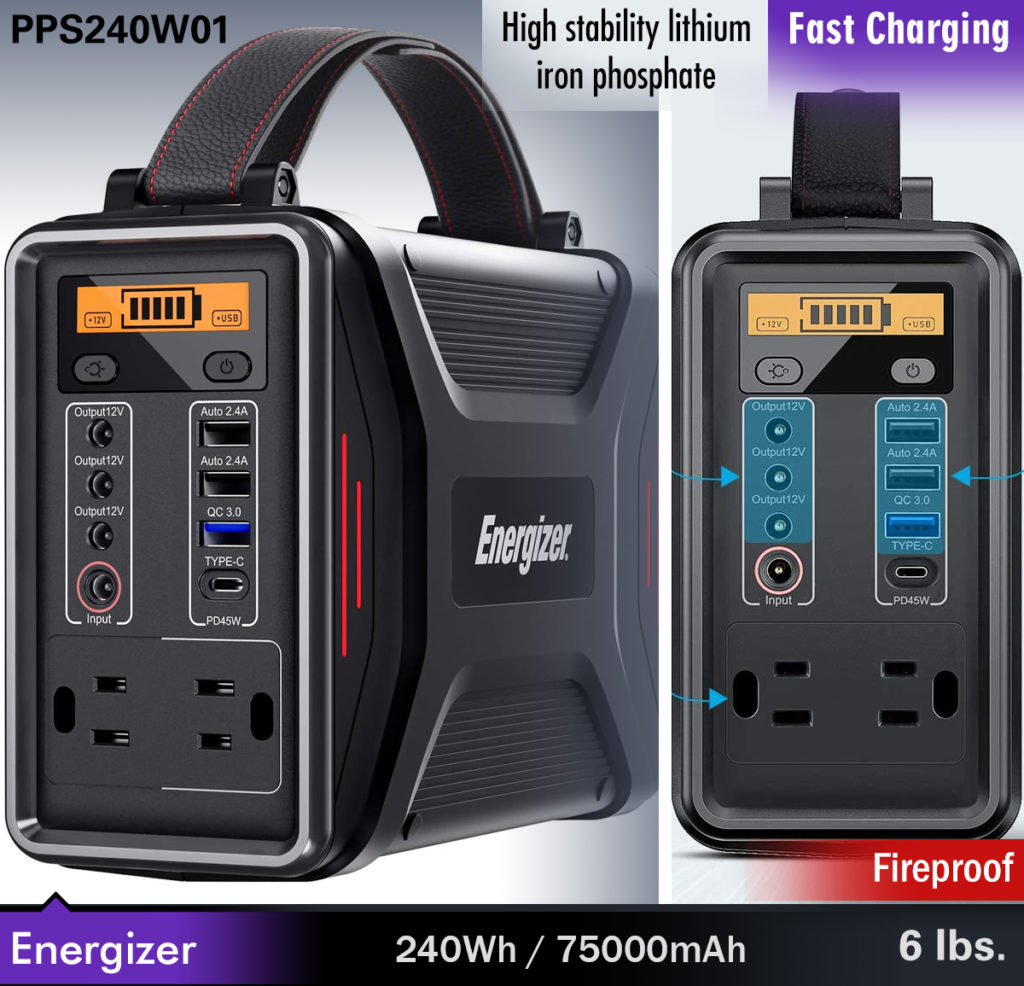
Features :
- FASTEST PORTABLE POWER SUPPLY: CYPRESS chip with the PD fast charging protocol. Compared with other products that labeled but actually don’t have USB-PD 3.0 license, PPS240W01 electric generator can make you enjoy the pleasure of charging speed.
- SAFEST POWER STATION: High stability lithium iron phosphate battery generator, 2000 cycles, PC V0 fireproof enclosure, UL, CE, FCC, PSE, ROHS certified, Abnormal alarm function for your emergency home use. Provides 12 months warranty.
- SMALLEST SIZE : Small generator, high integrated circuit, more space-saving, only 8 x 6.1 x 3.3in in a capacity of 75000mAh. Effective electrical energy conversion can reach 90%,2000 cycle, portable generators for camping quiet.
- POWER UP MORE : Indoor/outdoor portable ac power, 3 DC Output(12V/8A), 2 USB-A Port(5V/2.4A each), 1 QC3.0 Port(5V/18W), 1 PD 45W USB-C Port(Two Way), 2 Pure Sine Wave AC Outlet(110/200W max), support 9 devices at the same time.
- Power-Saving Solar Generators : Automatic sleep/shutdown function. 2 minutes of non-us will automatically sleep, press any key to wake up. 5 minutes of non-use will automatically shut down.Press and hold the LED light button and the power button for 3S at the same time to turn off the automatic shutdown function.
“This 240Wh power station is perfect for running your mobile fridge, portable fan, laptop, and other portable electronic gear. It has a nice leather carry handle and weighs just 2.7 kilos or 5.95lbs. It has a 45W USB Type C power delivery port for fast charging your phone or laptop.”
Overview:
Energizer is one of the most famous battery companies, and now they’ve come out with their own compact power station. While it isn’t radical or revolutionary, it does a lot of little things very well that make it a superior choice over other super compact power stations. For starters, it has a 2-way 45W power delivery spec USB Type C port which you can use to charge phones, laptops, and the power station itself.
The highlight of this Energizer power station is its ability to function in a wide range of climates. It can operate between temperatures ranging from just 23°F all the way up to 131°F. Unlike most other power stations that use Li-Ion batteries, this Energizer model is equipped with a Lifepo4 or Lithium Iron Phosphate battery. With superior thermal and chemical stability, the Lifepo4 batteries can stay safe under much higher temperatures compared to regular Li-ion. This comes in handy if you live in a particularly hot area, or have high ambient temperatures within the room (maybe you’ve got a gas stove running inside the apartment).
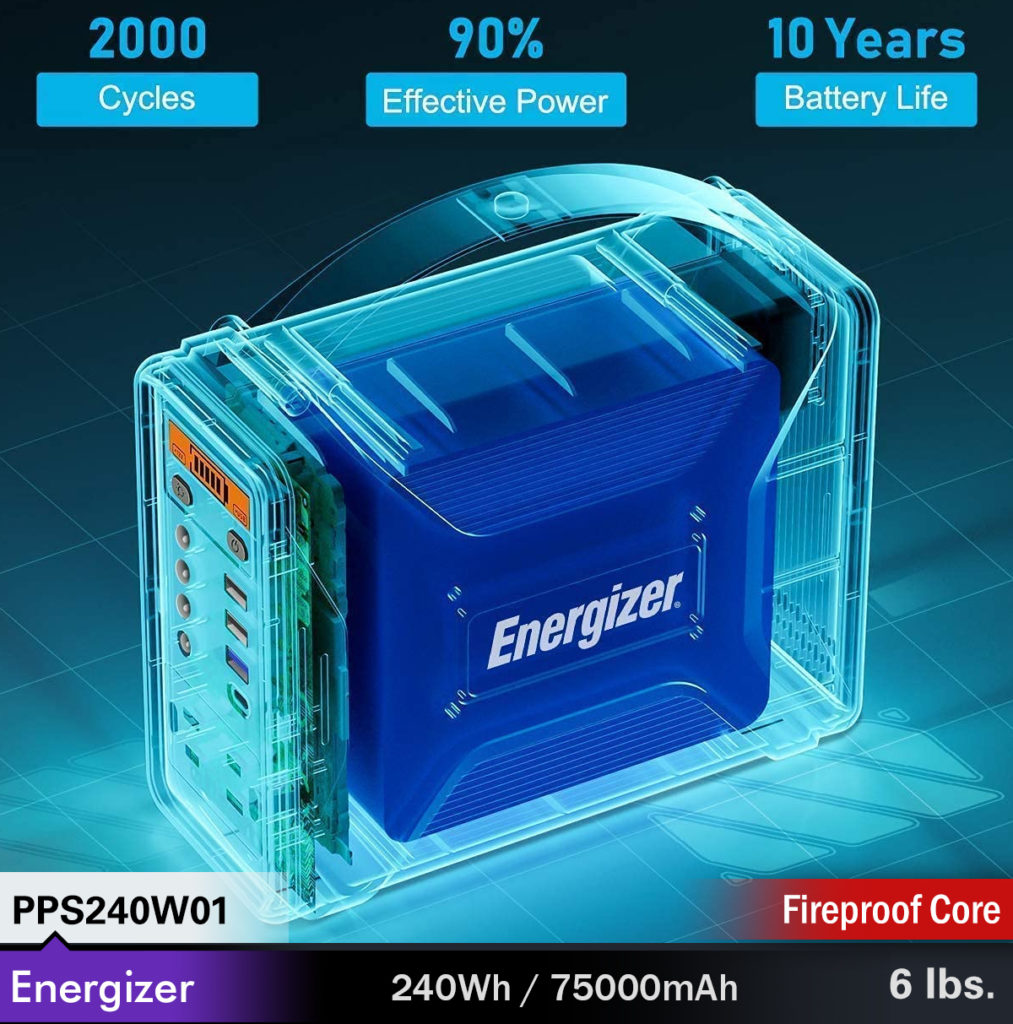
The same applies for super cool temperatures as well. As a result, battery drain and charging times are really consistent across a variety of ambient temperatures whether it be hot or cold. Lifepo4 batteries have longer lifetimes, so they retain more effective capacity after 500+ charging cycles compared to regular Li-Ion batteries.
There are specially designed air ducts running along the length of the PPS240W01 to a cooling fan which turns on only if things start to get hot. Otherwise the unit is dead silent. It is much narrower than competing models from other brands, so you can easily fit one of these on your desk. There are two 5V Type A ports, two 120V 3-prong ports, a QC 3.0 USB port, three 12V DC outputs, and a 45W Type C port. It comes with a car charging cable, AC adapter, and cigarette lighter cable.
Price wise, it is relatively affordable. If you want something cheap and reliable to power your laptop, router, and lights during an outage, this is very good. It is also built tough and can be carried around pretty easily. Not everyone has a ton of money to throw around during these times, which makes the Energizer an excellent choice over more pricey options from Goal Zero.
Review : Goal Zero / Yeti 1500X —
Recommended Indoor Apartment Generator
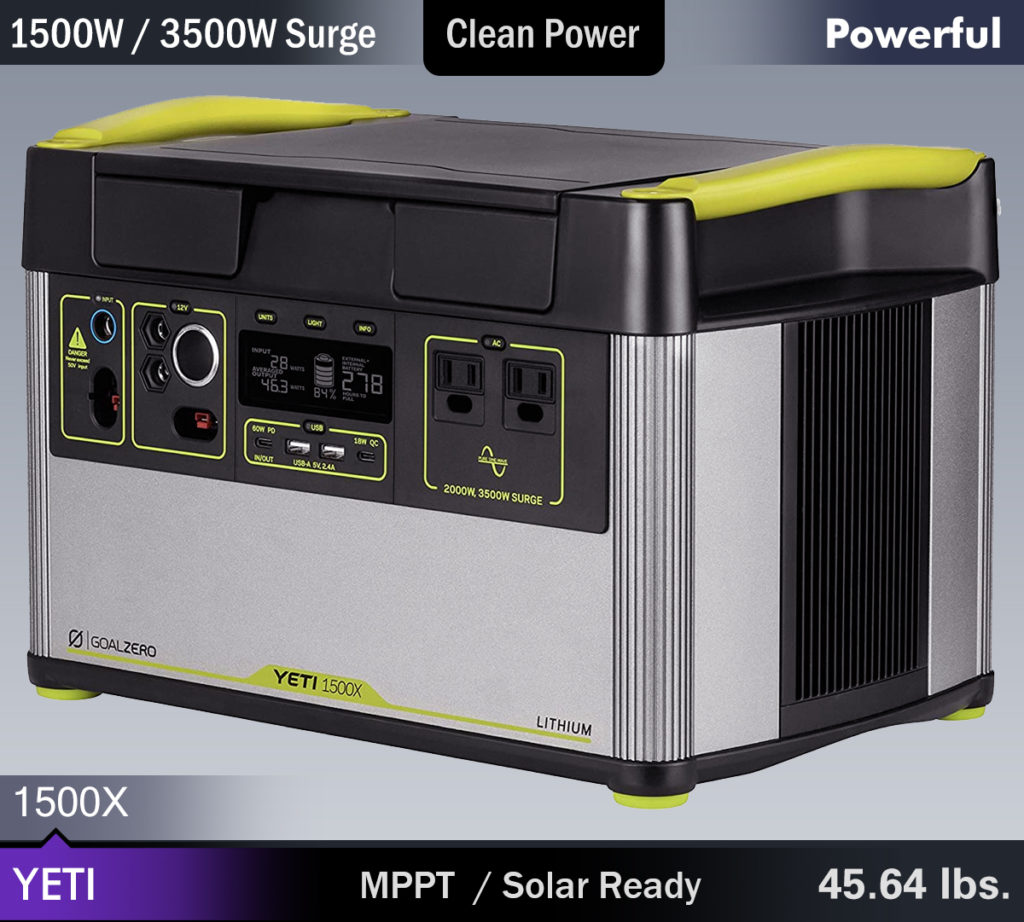
Features :
- Goodbye Gas Generator. Hello Yeti X. : With a lithium-ion battery at its core, the Goal Zero Yeti X equips you with safe, clean, portable power for camping, tailgating, off-grid events, workshops, and emergency home backup.
- Take Your Wall Outlet Anywhere :Increased 2000W AC (3500W Surge) inverter allows you to run power-hungry devices and appliances with confidence. Our new industry-leading inverter can handle surges from power tools, medical devices, and home appliances, including full-size refrigerators.
- Versatile Port Options : Power a wide range of devices with seven different port options including fast-charging 60W USB-C Power Delivery, multiple USB-A ports, regulated 12V, and two 120V AC ports.
- Experience Unlimited Power : Charge the Yeti 1500X from the sun with our portable solar panels while away from the grid and keep it topped off from a wall outlet when you’re home. Integrated MPPT charge controller ensures you’re getting the most efficient solar charge possible.
“Designed to be charged by solar power with an Anderson Power Pole input that accepts up to 660W and charges the Yeti 1500X in just 2.5hrs, this is the ideal choice for off-grid living. Or emergency backup power in apartments when the grid has been knocked out by a storm/ flood. The Yeti 1500X can comfortably run a refrigerator and even some power tools like table saws, drills, etc. ”
Overview:
With a massive 1516Wh Li-Ion battery and MPPT charge controller, the Yeti 1500X can both charge extremely fast while also powering your devices for extended periods of time. It has the number 1500 in its name, but this is actually a 2000W continuous and 3500W surge power station. It has built-in W-Fi connectivity so you can link it up with your Yeti app. The latest version of the Yeti app allows you to track real-time power consumption and view historical power data. You can toggle individual ports on and off from your phone and set charging profiles to optimize battery life.
VIDEO | A Closer Look at the YETI 1500X
The Yeti 1500X is optimized for solar power with its APP (Anderson Power Pole) input and MPPT charge controller. If you hook up three Boulder 200 panels (a total of 600W), it can charge up in less than 3 hours under ideal conditions. From the wall, it takes 14 hours to charge with the included adapter. Or 7 hours, if you’ve got a 230W outlet.
There is a bay for the Yeti Link expansion module. This allows you to connect an external power pack or integrated the Yeti 1500X into your car’s 12V power system for easier charging on the move. The bay also contains an 8mm 120W input port and APP 30 amp output for better cord management. I just wish they put more 120V AC ports on this power station, since it just has 2. The Yeti 1500X can run a laptop for 30+ hours, a mini fridge for up to 44 hours, a 1000W microwave for 2 hours. It can easily power a large side by side refrigerator for an entire day.
How Do Portable Power Stations Work?
How do indoor generators differ from a traditional gas generator? Hint : The gas 😃
A portable power station or indoor generator is just like the UPS (uninterruptible power supply) that powers your computer during an outage. Just a lot bigger in capacity and with more ports. It contains a battery pack (typically lithium-ion) and an inverter. The battery pack outputs DC power which the inverter module converts into AC and steps up to the correct voltage and hertz (110 to 120 volts at 60Hz). All your home appliances run on AC power; some convert that back into DC with their own power supply (like your computer).
Since there is no engine, you don’t get any fumes or noise like you would with a conventional generator. And that means no risks with running one of these indoors in an apartment or any other confined space. That’s not all, you also get pure sine wave power which is comparable in quality and stability to what you get from the wall through the utility grid. So any sensitive electronics with microchips will run just fine (OLED TV, computer, phone, camera, etc.).
All indoor generators are capable of supplying both DC and AC power, something only inverter generators could do before power stations became mainstream. They also have USB ports so you can power your phone or laptop directly. No need to clog up the AC outlets with adapters. So you can use the AC outlets to power something like a portable fan, fridge, TV, etc.
They aren’t 100% silent however, since there is usually at least one fan to cool the inverter circuitry and/ or battery. After all, you have to keep batteries at an optimum temperature range if you want them to charge at high speeds. But these fans are smart and won’t kick in until they are required to. And they can modulate their RPM to only spin as fast as needed. So think of them like the fans in your computer case because the loudness levels are also similar.
As of now, if you want to get emergency backup indoors a portable power station is the only generator you can buy.
Portable Power Station vs Gas-Powered Generator
There are pros and cons to both systems. Portable power stations are quiet and release zero toxic fumes. However, they can take quite a bit of time to charge. On the other hand, a gas powered generator can refuel in minutes. A portable gas generator will backup your laptop, TV, and other electrical appliances for a few hours at best. Whereas a gas generator can run for days before you need to shut it down.
A gas generator can only be run outdoors in well-ventilated areas, but a portable power station can operate anywhere. Indoors outdoors, it doesn’t matter as long as you have the means to recharge it (solar, car, or wall power). Gas generators are generally heavier and physically larger for the same wattage compared to indoor generators. That’s because they have an engine, fuel tank, chassis, exhaust system , etc. Whereas an indoor generator just has a battery pack and inverter. These are much more compact and easier to pack into smaller spaces. Plus you don’t need a solid metal tube frame running around the whole thing for structural integrity since a simple plastic outer shell is enough.
In terms of reliability, I believe gas wins. It is going to work as long as you have fuel stored at home, and will turn on every time you pull that cord if you maintain it properly. And it will last decades with some parts replacements. Portable power stations have complicated electronic circuitry that is hard to repair at home unless you are really good with electronics. They also have batteries which lose their ability to hold charge after a few hundred charge cycles (usually after the 500th charge). And solar charging is sort of unreliable since you never know when the weather gods decide to be uncooperative and cover the sky with clouds.
Also, there’s something about trying to power your electronic equipment with a generator that itself requires electricity to function which really doesn’t feel right. If you’re serious about off-grid living a network of solar panels will do the job. And it’s super clean for the environment. A lot of people care about reducing their impact on the environment, trying to make power in cleaner and more sustainable ways.
If you already power your home with solar energy, getting an indoor generator just makes sense over a gas powered generator. It synchronizes with the rest of your equipment and integrates into a smart home if the power station supports Wi-Fi/ Bluetooth connectivity. Plus, it’s safer with kids and pets in the house. The exterior of a portable power station doesn’t get very hot. So you don’t have to worry about someone getting burned by accidentally touching it. And since you don’t have to store gasoline, it reduces the potential risk or a fire hazard.
For those of you living in apartments, the lease agreement might have rules prohibiting the use of gasoline generators. And you might violate local fire codes by storing gasoline in the apartment. One final thing to consider is the fact that portable power stations are quite expensive. You can get a decent inverter generator in the 1000 to 2000 watt range for under 1000 bucks. Conventional open-frame generators are even cheaper.
But a 1000 to 2000 watt portable power station is much more costly. In the short term this might be a deterrent preventing you from considering one, especially with how our finances are thanks to this global pandemic. Many people don’t have a job and are stacking up on their debts. But think about it from a long term perspective. You spend zero money on gas, and can potentially get free power from solar panels. And you don’t have to think about what appliances you shouldn’t power, because the energy is clean sine wave just like what you get from the wall. It is also less hazardous and much easier to live with for people in apartments.
Understanding The Technical Terms
Throughout this article, I’ve mentioned things like amps, volts, watt-hours, milliamp hours, etc. What do all these things mean? Why should you care? If you wish to purchase the right portable power station that is capable of powering all your essential equipment for the required amount of time, it’s important that you pay attention to what these terms mean.
On top of that, many manufacturers will manipulate data and present certain metrics in ways that make it seem as though their generator is better. A bigger number means better performance to many oblivious consumers. For example, the “Dominator 3000” from company “X” might actually be capable of 2000 watts continuous with 3000 watts of surge. Continuous power is the amount of power that the inverter can output reliably for an extended period of time. Surge power is only available for a few seconds, like when a motor needs that additional current draw at the start to overcome resistance before it gets running.
Any appliance with just resistive load has the same starting and running watts. TVs, microwaves, hair dryers, computers, etc. have similar starting and running watts. But capacitive loads like what you find in pumps, compressors, etc. can have a starting wattage up to 2 or even 3 times higher than their running wattage. Refrigerators draw the most power when their compressor is working, same applies for air conditioners. A lot of power tools have high starting wattages. So you need larger power stations like the Yeti 1500X or EGO NEXUS to run jobsite tools/ air conditioners.
Manufacturers measure the capacity of power station batteries with milliamp hour or mAh. But this isn’t indicative of how much power the battery can deliver, that is determined through watt hours. You multiply milliamp hours with volts to get power over time. For example, a 10000 mAh battery rated for 5V can deliver 50000 milliwatt hours or 50 Watt hours (Wh). Which means it can power a load of 50 watts for one hour.
Watts = voltage x current. Think of it like a plumbing pipe. You have water flowing through this pipe. Voltage tells you the pressure difference between both ends of the pipe, or the water pressure/ force with which the water flows. Amperage is simply the volume of water flowing through a cross section of the pipe at any given second. Replace water with electrons and you have electricity. Volts measures the electric potential or “pressure” across a conductor while amps measures the volume of charge flowing through a cross section of the conductor at any given time.
High draw appliances like washing machines, dishwashers, dryers, etc. require a lot of amps to work. And you need to make sure your portable power station’s inverter can handle that amount of current. Read the specs sheet, ensure that it can handle at least 15 or 20 amps if you wish to run tools or similar high draw equipment. Also pay attention to surge vs continuous wattage.
Note: If you’re placing your generator on the balcony, make sure it has some level of water resistance since it’ll be subjected to rainfall and pooled up water. The outlets should have some kind of protective rubber cover on them to prevent moisture and dust from getting in contact with the pins. And make sure your extension cord doesn’t have any breaks in the insulation or you’ll get a nasty shock when you walk out into the balcony with water pooled up. All modern portable power stations have built-in overcurrent (excess current beyond the device rating) protection and will trigger the breakers when they detect a short, but you shouldn’t risk it. Keep yourself and your generator safe from the elements.
Is It Safe To Use A Gas Generator on Your Balcony?
Nope. Conventional open-frame generators are a no-go since they have no catalytic converters and are not fuel-efficient. As a result they emit tons of fumes, a lot of which is dangerous carbon monoxide. CO or carbon monoxide is an odorless, tasteless gas that can seep into your living quarters. In small quantities it causes difficulty in breathing and nausea/ headaches. But in large enough quantities this gas can be lethal since it impedes the ability of your red blood cells (RBC) to absorb oxygen taken in by your lungs. It replaces the oxygen and bonds with your RBC’s, potentially causing vital organs like the heart and brain to fail. People have often died in their sleep because of CO poisoning. It happens all the time.
Carbon monoxide is odorless so you can’t tell if lethal fumes are surrounding you without a CO detector. Eventually you’ll feel light-headed, but by then, it’s too late. CO detectors are a must-have if you’re running a portable gas powered generator near the home. Never operate a gas generator less than 10 feet from an open door or window, and to be honest, err on the side of caution and keep gas generators as far away as possible from indoor spaces, including garages, barns and sheds.
Often times, storm hit areas employ portable generators to power their households when the grid is down. This is when you see a second wave of deaths (first wave from the storm itself). CO poisoning kills dozens every year. According to a report released by the CPSC in 2013, there were a total of 931 non-fire related deaths due to CO inhalation between 1999 and 2012. And 800 of these were from portable generators.
There was this news story in April of 2015 in which a family of 8 was reported to have died from carbon monoxide poisoning. They had a generator running inside the house. Electricity had been shut off due to unpaid bills, and the father had been using a gasoline powered portable generator. Even if you live in a regular house and not an apartment, a generator is dangerous if it’s close enough to the home (10 feet or so). If you have a small porch or attached garage, don’t run a generator there. It should be at least 30 feet away from any doors or windows. The amount of CO emitted from a portable generator is several times higher than what comes out of a running car’s exhaust.
Note: A Honda EU2200i is what I would choose if I had to put a generator on my balcony/ patio, it is quiet and extremely fuel efficient. I suggest you only get one if you live on the ground floor and your lease allows it. If you live in a high rise and run a gas generator on your balcony, the fumes might seep down into lower floors. Plus refueling and storing gas within apartment premises is a potential fire hazard. I am still against the idea.
Read more about generator safety :
Getting More Runtime Out Of Your Indoor Generator
Some indoor generators support parallel operation so you can hook them up with another unit of the same model. Or maybe an external battery pack if your generator supports it. The Goal Zero Yeti Link expansion module allows you to chain an expansion tank with your Yeti 1000/ 1400/ 3000. These expansion packs are quite heavy and take up extra floor space. At that point, you might as well consider purchasing an inverter and a few batteries to power your entire home. A portable power station is essentially an inverter + battery pack built into a compact package that you can carry around.
If external battery packs and chaining generators aren’t an option, you could look into putting some solar panels on your balcony. This way you can charge the generator while it is powering your devices. Solar panels range from 60W all the way up to 200W. They are easy to store since they fold up, and come with convenient carry cases so you can take them outdoors with you on camping trips. Almost all modern portable power station support charging via solar panels.
Finally, you need to limit your power consumption. Just like dieting, you want to cut down on anything that isn’t necessary for you to function. If the power grid is down and you are on your own, do you really need to game on your powerful desktop PC? Just watch some movies on your laptop instead, or read a book. Both of those options consume much less power. Don’t try to run everything in the house, only the essential stuff that helps you survive. Like the fridge, lights, phone, laptop, internet router, etc. If you can get by without using the air conditioning or heater, do so. Can you make something basic with the crock-pot instead of turning on your 1000W microwave oven? Do you need that food processor, or can you manage with a mortar and pestle?
It all comes down to how frugal you can be, and what comforts you’re willing to sacrifice so you can make it through the entirety of the outage without any hiccups. Call up your utility company and ask when they expect the outage to be resolved. That should allow you to construct a plan on which appliances you can use and for how long with the amount of backup power you’ve got.
How The COVID-19 Pandemic Has Made Us More Self-Reliant
If you haven’t already purchased a generator, now is the time to get one. You want to reduce your potential exposure to the CoVID-19 virus as much as possible, that means staying in your home and stocking up on rations. Especially if it’s hurricane season. Canned food, water, LED lights, etc. are all nice to have if you live in a storm-prone area like the Gulf Coast. Hurricane season is going to leave plenty of people without power, and you don’t want to constantly travel between the store/ gas station and your home.
If you live in a regular home you can afford to get a powerful gas generator — as far as space goes. You’ll have ample space between the gas generator and the windows. You can place your generator in the lawn, and hook it up to your home circuits with a transfer switch. But for people like me who are living in apartments, there is no such option. We can’t modify our homes with a transfer switch, or even run a generator. Our lease agreements have strict rules regarding noise and home modifications. So the best choice is to get something that is a simple plug and play system. Portable power stations emit zero toxic fumes, so you don’t have to worry about sleeping with one running in the background. They also make no noise, except for the little cooling fans which aren’t even audible if you’re more than 5 feet away.
I have been spending a lot of time watching cooking channels on YouTube, learning how to cook during this pandemic. It is a nice skill to have, and it keeps you healthy. Takeout is nice every once in a while, but you don’t want to turn it into a habit. It is bad for your body, and your wallet. Plus, with how many people we’ve got infected with the virus, you never know if the guy delivering your food is also handing over some complementary virus samples.
When you do order food, make sure you’re wearing a mask and sanitary gloves as you go to pick it up. Throw the packaging, ditch the gloves, and wash your hands thoroughly for at least 20 seconds with sanitizer or anti microbial hand-wash before you eat. The same applies when you buy groceries at the store (or order it online as I often do).
The pandemic has also increased our reliance on electronic gadgets. Most of us are locked up in our own homes, working and communicating with colleagues/ friends through Skype or Zoom calls. Computer and console sales are predicted to spike, and new hardware is almost always out of stock. The global crisis has forced people into their homes, and they are buying stuff that will help them weather this storm more comfortably. Personal fitness equipment, tablets for entertainment, game consoles, TVs, webcams, etc. are being sold at much higher rates.
And guess what you need to power all this stuff – electricity. Hence searches on Google for indoor generators have spiked massively. And you have to understand that a lot of people in big cities live within apartments or condos. Some of these places don’t have a balcony, which makes a portable power station the only choice if you wish to run your computer or fridge during an outage.
If you’re cooking more and working from home, an indoor generator is something to consider. Not only is it safer and quieter than a gas generator, but it can also run your computer and other sensitive electronics. Conventional generators aren’t suited to powering laptops or phones because they don’t produce pure sine wave power.
Conclusion : Indoor Generators are a Valuable Device for your Apartment or Condo
I hope this article gave you some perspective on how an indoor generator helps you work from home more comfortably, decreasing your reliance on the power grid. Solar charging is one of the best things if you live off-grid or in an area that is frequently affect by hurricanes. Even if the grid is down for weeks, you can power essential equipment with a couple of solar panels and your indoor generator.
Cooking your own food is a great way to save on money and boost your overall healthiness (as well as mentality). Induction cooktops are an excellent choice for students living in dorms, or people living in apartments. They don’t heat up the room as much as a gas stove and are very safe to use since they directly heat the utensil. You need a 1500 to 2000W indoor generator to power one of these, something like the Yeti 1500X or Delta 1300. Or maybe multiple indoor generators – one for the cooktop, and another for your fridge + computer.
Take your financial situation into account, decide how many things you need to power, and how much floor space you have. I made sure to review a wide range of indoor generators in this article, some are tiny while others are massive. All of them are silent and don’t emit any fumes, so choose one that fits your needs and budget.
